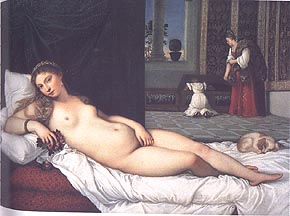Edgar Wind
Pagan Mysteries of the Renaissance
p. 141: In Titian's Venus of Urbino the goddess is stretched out in sumptuous repose, facing the beholder with the placid air of a Venetian odalisque. It would seem, despite the reminiscence of a Venus Pudica, that an undisquised hedonism had at last dispelled the Platonic metaphors. But in the background, by way of a gloss, two servants are occupied with a cassone out of which they have taken the mantle of Venus. In this marginal episode, which might be a /p. 142: a Dutch interior, the cosmic mantle designed to discover the celestial Venus has been reduced to comfortable domestic apparel befitting a toilette de Vénus,, and if there is a touch of drôlerie in the vernacular rendering of such a well-known mythological attribure, the change of style is the right accompaniment to the luxurious figure in the foreground. Epicurean Pleasure in its pure form, which Ficino reserved for the joys of heaven, is readmitted to earth in Titian's paintings; but its effect is heightened by an echo of Platonism which enters as an accompanying theme into these hymns of physical well-being....
